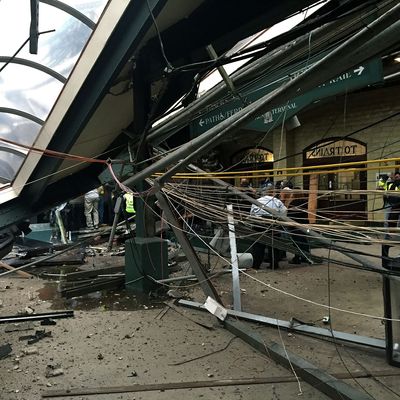
The New Jersey Transit train that crashed into a Hoboken station at twice the speed limit last month was so severely wrecked that is has slowed the National Transportation Safety Board’s investigation. The agency released Thursday a preliminary report about the fatal September 29 crash, which left 1 person dead and 110 injured. This latest update backs up early findings from the train’s data recorder and front-facing camera, but also says that key equipment is destroyed — specifically, the “electrical communication network” that ran the brakes, signal, and propulsion control. The NTSB needs to do additional tests to rule out the possibility of a mechanical malfunction, though it hasn’t said what those tests will entail.
The NTSB was able to repair and test the air brakes in the front and rear cabs. All were reportedly in working order. According to the report, investigators also restored and tested the signal system, which functioned properly except for the signal at the end of track 5, which was crushed in the wreck.
The preliminary report also included a more detailed interview with the train’s engineer and conductor. The operator, previously identified as Thomas Gallagher, told investigators he woke up on the floor in the front cab and doesn’t remember the crash. What he told officials he does remember: He felt well-rested when he checked in for duty at 6:46 a.m. that morning; he checked the brakes before departing, and everything checked out. The train was running normally as it approached the terminal, he says. Nothing blocked his view. He said he glanced at his watch, which showed the train was about six minutes late entering the station; he checked the speedometer, which indicated that the train was going ten miles per hour — the last thing he remembers.
Data pulled from the black-box recorder showed that the train was going more than double that — 21 miles per hour — before the moment of impact. The event recorder also revealed that the train was cruising at eight miles per hour about 38 seconds before the crash when the throttle “increased” from the idle position and the train accelerated. The emergency brake was pulled one second before the the train rammed past the bumper at the end of the platform, the NTSB found.
The conductor told investigators that he did not notice anything strange in Gallagher’s demeanor that morning (they’d worked together before). He also said he didn’t notice anything unusual about the train’s speed while heading into the station — though, he added that he was distracted because the train was so overcrowded. On the day of the accident, this train, No. 1614, had one less car — four, instead of five — and the conductor struggled to collect fares.
The NTSB took blood and urine samples for the entire crew for toxicology tests.
The latest report does not give a cause for the crash, and it’s clear the investigation is going to take many, many months. Meanwhile, New Jersey Transit’s restored limited service to the Hoboken Station this week. The mangled train was finally removed from last Thursday, and crews are just starting repair work on the damaged track 5 and the areas adjacent.





























